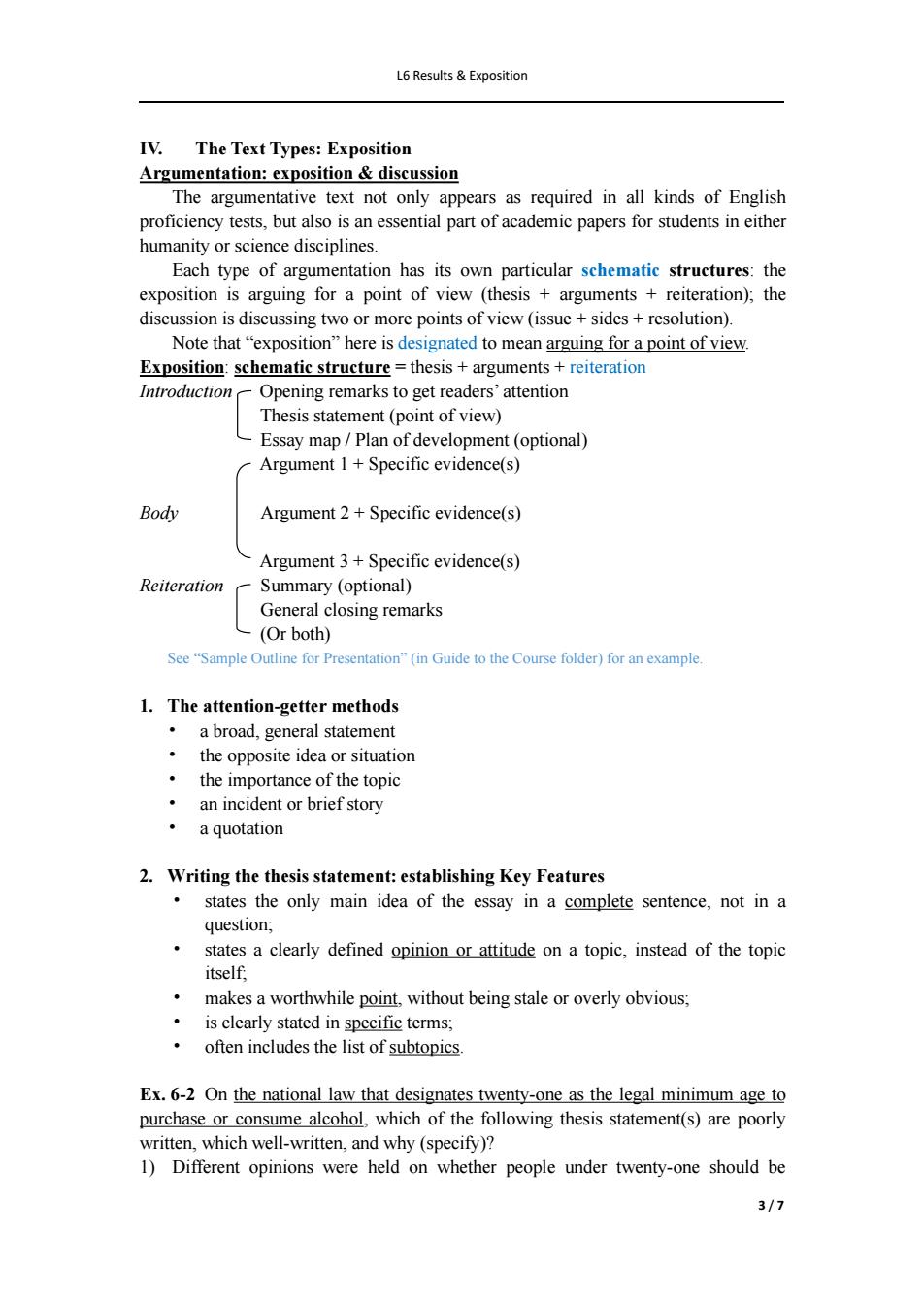正在加载图片...

L6 Results Exposition IV.The Text Types:Exposition Argumentation:exposition discussion The argumentative text not only appears as required in all kinds of English proficiency tests,but also is an essential part of academic papers for students in either humanity or science disciplines. Each type of argumentation has its own particular schematic structures:the exposition is arguing for a point of view (thesis arguments +reiteration);the discussion is discussing two or more points of view (issue sides resolution). Note that"exposition"here is designated to mean arguing for a point of view. Exposition:schematic structure thesis arguments reiteration Introductionc Opening remarks to get readers'attention Thesis statement(point of view) Essay map/Plan of development (optional) Argument 1 +Specific evidence(s) Body Argument 2 Specific evidence(s) Argument 3+Specific evidence(s) Reiteration Summary (optional) General closing remarks (Or both) See"Sample Outline for Presentation"(in Guide to the Course folder)for an example. 1.The attention-getter methods a broad,general statement the opposite idea or situation the importance of the topic an incident or brief story ·a quotation 2.Writing the thesis statement:establishing Key Features states the only main idea of the essay in a complete sentence,not in a question; states a clearly defined opinion or attitude on a topic,instead of the topic itself: makes a worthwhile point,without being stale or overly obvious; is clearly stated in specific terms; often includes the list of subtopics. Ex.6-2 On the national law that designates twenty-one as the legal minimum age to purchase or consume alcohol,which of the following thesis statement(s)are poorly written,which well-written,and why (specify)? 1)Different opinions were held on whether people under twenty-one should be 3/7L6 Results & Exposition 3 / 7 IV. The Text Types: Exposition Argumentation: exposition & discussion The argumentative text not only appears as required in all kinds of English proficiency tests, but also is an essential part of academic papers for students in either humanity or science disciplines. Each type of argumentation has its own particular schematic structures: the exposition is arguing for a point of view (thesis + arguments + reiteration); the discussion is discussing two or more points of view (issue + sides + resolution). Note that “exposition” here is designated to mean arguing for a point of view. Exposition: schematic structure = thesis + arguments + reiteration Introduction Opening remarks to get readers’ attention Thesis statement (point of view) Essay map / Plan of development (optional) Argument 1 + Specific evidence(s) Body Argument 2 + Specific evidence(s) Argument 3 + Specific evidence(s) Reiteration Summary (optional) General closing remarks (Or both) See “Sample Outline for Presentation” (in Guide to the Course folder) for an example. 1. The attention-getter methods • a broad, general statement • the opposite idea or situation • the importance of the topic • an incident or brief story • a quotation 2. Writing the thesis statement: establishing Key Features • states the only main idea of the essay in a complete sentence, not in a question; • states a clearly defined opinion or attitude on a topic, instead of the topic itself; • makes a worthwhile point, without being stale or overly obvious; • is clearly stated in specific terms; • often includes the list of subtopics. Ex. 6-2 On the national law that designates twenty-one as the legal minimum age to purchase or consume alcohol, which of the following thesis statement(s) are poorly written, which well-written, and why (specify)? 1) Different opinions were held on whether people under twenty-one should be